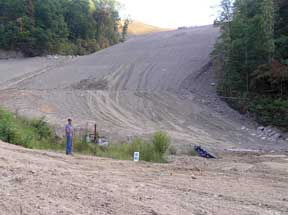Judge rules against restoring stream protection
A federal judge today refused to reverse a last-minute Bush administration act that did away with an important rule designed to protect streams from mining.
The Stream Buffer Zone (SBZ) rule – in place since 1983 – required coal companies to keep the impact of mining at least 100 feet from streams. Though that rule was generally ignored by federal and state mining agencies, it provided legal grounds for citizens to challenge valley fill permits. Therefore, the Bush administration went through a drawn-out process to re-write the rule in a way to remove the protection and actually give incentives to coal companies to mine in streams.

A few months after taking office, the Obama administration said it would intervene in an ongoing lawsuit asking the courts to reverse the Bush action. But in turning down the request, U.S. District Judge Henry Kennedy Jr. likened that to changing the rules without proper process or public input.
The National Mining Association applauded Kennedy's decision. Spokesman Luke Popovich told the Associated Press that the Bush administration spent better than five years rewriting the stream buffer rule, including taking public input. However, the AP did not report that the Bush administration received tens of thousands of letters about their proposal to eliminate the SBZ rule, the vast majority opposing the change.
The Obama administration may appeal the ruling. It could also initiate its own rule-making process to re-write and restore the SBZ rule. It could also support legislation in Congress that would strengthen the Clean Water Act with the same goal of stopping the dumping of toxic mining wastes into Appalachian streams.
Want to help do something about this? Start here to learn about the Clean Water Protection Act, and here for the Appalachian Restoration Act.
Some facts about the dumping of mining wastes in streams.
- more than 1,400 miles of streams in Kentucky have been eliminated (buried under millions of tons of waste) or severely damaged by the dumping of mining wastes into valleys (figure compiled from the reports of several federal agencies);
- stopping these valley fills, or significantly restricting their size, would have a negligible effect on the cost of electricity (U.S. EPA based on the findings of economic consultants);
- selenium, a carcinogen, has been found only in those Appalachian streams below valley fills (U.S. EPA)
- sedimentation, largely from mining, is by far the worst pollutant in most eastern Kentucky streams (Ky. Division of Water, research by Eastern Kentucky University and other studies);
- Reconstructed channels do not come close to replacing the vital ecological functions of natural headwater streams, services that include water quality, flood control and providing nutrients for downstream aquatic life (U.S. EPA, Dr. Margaret Palmer, a stream restoration expert; Dr. Nathaniel Hitt, researcher at Virginia Tech University).
Recent News
Kentucky’s past legislative session showed alarming trend toward government secrecy
Churchill Downs takes more than it gives. That's why the Kentucky Derby is a no-go for me
‘We must never forget.’ Kentucky town installs markers for lynching victims.
Featured Posts
Protecting the Earth
TJC Rolling Out The Vote Tour – a KFTC Reflection Essay
KFTC Voter Empowerment Contractor Reflection Essay
Archives
- Home
- |
- Sitemap
- |
- Get Involved
- |
- Privacy Policy
- |
- Press
- |
- About
- |
- Bill Tracker
- |
- Contact
- |
- Links
- |
- RSS


Add new comment